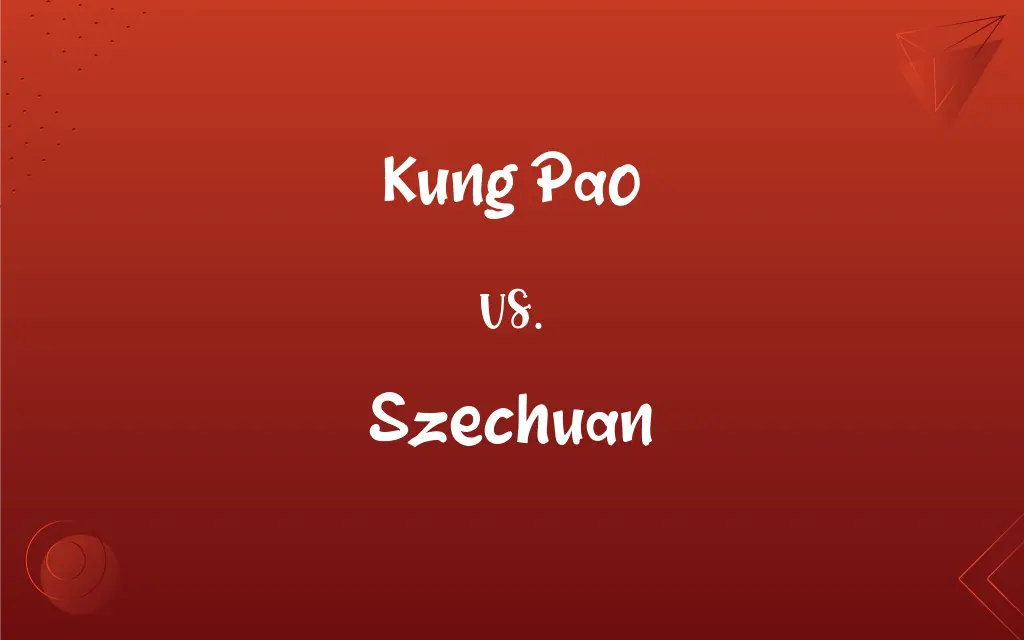Kung Pao vs. Szechuan: What's the Difference?
Edited by Aimie Carlson || By Janet White || Updated on July 9, 2024
Kung Pao is a specific dish with peanuts, chicken, and chili peppers, while Szechuan refers to a spicy Chinese cuisine style from Sichuan Province.

Key Differences
Kung Pao and Szechuan both have their roots in Chinese culinary traditions, but they are distinct in terms of dishes and flavor profiles. Kung Pao, also known as Kung Pao Chicken, is a popular dish made from diced chicken stir-fried with peanuts, vegetables, and chili peppers. It's known for its delectable combination of sweet, savory, and spicy flavors. In contrast, Szechuan isn't a single dish but refers to the cuisine from China's Sichuan Province, known for its bold flavors, particularly the heat from Sichuan peppercorns and chilies.
When discussing the heat levels of the two, Kung Pao often employs dried chili peppers to deliver its kick. This dish, with its balanced flavors, can be adjusted in terms of spiciness according to individual preferences. Szechuan cuisine, on the other hand, is renowned for its numbing heat, which is derived from the unique Sichuan peppercorns. These peppercorns not only bring heat but also a distinct numbing sensation, setting Szechuan dishes apart from other spicy cuisines.
Ingredients play a crucial role in differentiating between Kung Pao and Szechuan. Kung Pao's signature ingredients include chicken, peanuts, and chili peppers, often accompanied by a savory sauce. Szechuan cuisine is diverse, with a myriad of ingredients ranging from meats like beef and pork to various vegetables, all cooked with generous amounts of garlic, fermented bean paste, and, of course, Sichuan peppercorns.
Another differentiator is the global adaptation and popularity of these terms. Kung Pao, due to its specific nature as a dish, has seen global variations, especially in Western Chinese restaurants. The dish may sometimes be less spicy or have alternative ingredients in non-Chinese settings. Szechuan, representing a whole cuisine, has various dishes that have been adapted worldwide, but the fundamental essence of bold and spicy flavors remains consistent.
In essence, while both Kung Pao and Szechuan are representatives of Chinese culinary arts, they stand apart in their identity. Kung Pao is a cherished dish with a specific set of ingredients and taste, whereas Szechuan is a vast culinary landscape known for its fiery and bold dishes.
ADVERTISEMENT
Comparison Chart
Nature
A specific dish
A style of cuisine
Main Ingredients
Chicken, peanuts, chili peppers
Varies, but often includes Sichuan peppercorns
Flavor Profile
Sweet, savory, and spicy
Spicy and numbing
Origin
Chinese cuisine with global adaptations
Sichuan Province in China
Associated Sensation
Spicy kick from chili peppers
Numbing heat from Sichuan peppercorns
ADVERTISEMENT
Kung Pao and Szechuan Definitions
Kung Pao
A popular choice for those seeking a spicy Chinese meal.
I always gravitate towards Kung Pao when I'm in the mood for some heat
Szechuan
A Chinese cuisine style known for its spicy and bold flavors.
I love the numbing heat that Szechuan dishes offer.
Kung Pao
A dish often associated with Western Chinese restaurants.
Kung Pao Shrimp is a delightful seafood twist on the traditional chicken dish.
Szechuan
A culinary tradition originating from Sichuan Province in China.
Traditional Szechuan cooking employs a generous use of garlic and Sichuan peppercorns.
Kung Pao
A Chinese stir-fried dish with chicken, peanuts, and chili peppers.
We ordered Kung Pao Chicken for dinner, and it was deliciously spicy.
Szechuan
A broad range of dishes with an emphasis on heat and robust flavors.
The restaurant offers an array of Szechuan specialties, each spicier than the last.
Kung Pao
A culinary creation known for its balance of sweet, savory, and spicy flavors.
The chef's take on Kung Pao incorporated cashews instead of peanuts.
Szechuan
Renowned for the unique numbing sensation from Sichuan peppercorns.
The Szechuan beef was fiery and had that characteristic numbing effect.
Kung Pao
A stir-fry preparation with a rich, glossy sauce.
The Kung Pao sauce added a depth of flavor to the dish.
Szechuan
Often associated with red chili oil and spicy bean paste.
The Szechuan soup had a deep red hue from the chili oil
Szechuan
A populous province of south central China
FAQs
Can I find vegetarian versions of Kung Pao?
Absolutely, Kung Pao tofu or vegetables are popular vegetarian alternatives.
Are peanuts essential for Kung Pao?
While traditional Kung Pao has peanuts, some variations might use cashews or omit nuts altogether.
Does Szechuan cuisine always mean the food will be extremely spicy?
While Szechuan is known for its heat, there are milder dishes within the cuisine.
Is garlic a common ingredient in Szechuan cooking?
Yes, garlic is frequently used in Szechuan dishes.
What gives Szechuan dishes their unique numbing sensation?
The numbing effect comes from Sichuan peppercorns.
Is Kung Pao sauce available for purchase?
Many grocery stores offer bottled Kung Pao sauce, and recipes are available for homemade versions.
Is Kung Pao native to Sichuan Province?
No, Kung Pao originates from the Shandong and Guizhou provinces.
Is Kung Pao always made with chicken?
Traditionally, yes, but there are variations like Kung Pao shrimp or tofu.
Are there other notable ingredients in Szechuan cuisine besides peppercorns?
Fermented bean paste, garlic, and chili oil are among other key ingredients in Szechuan cooking.
What kind of vegetables are commonly used in Szechuan dishes?
Bok choy, bell peppers, mushrooms, and eggplant are some commonly used vegetables.
Can I make Kung Pao without nuts due to allergies?
Yes, the nuts can be omitted without compromising the core flavor of the dish.
Can Kung Pao be made without meat?
Yes, versions like Kung Pao tofu or simply with vegetables are available.
Is Szechuan the spiciest Chinese cuisine?
It's among the spiciest, but spiciness can vary based on preparation and individual dishes.
What meats are commonly used in Szechuan cuisine?
Beef, chicken, and pork are staples, though many other meats and seafood can be used.
What kind of rice pairs best with Szechuan dishes?
Steamed jasmine or white rice is commonly served with Szechuan dishes to balance the heat.
Can Kung Pao be mild in terms of heat?
The spiciness of Kung Pao can be adjusted based on preference.
What is the base of the sauce in a Kung Pao dish?
It typically includes soy sauce, hoisin sauce, and sesame oil, among other ingredients.
Are there seafood versions of Kung Pao?
Yes, variations like Kung Pao shrimp or fish are available.
What makes Szechuan dishes so flavorful?
A combination of spices, sauces, and cooking techniques brings out the depth of flavors in Szechuan dishes.
Is tofu prevalent in Szechuan cuisine?
Yes, tofu, especially the soft or silken kind, is often used in spicy Szechuan preparations.
About Author
Written by
Janet WhiteJanet White has been an esteemed writer and blogger for Difference Wiki. Holding a Master's degree in Science and Medical Journalism from the prestigious Boston University, she has consistently demonstrated her expertise and passion for her field. When she's not immersed in her work, Janet relishes her time exercising, delving into a good book, and cherishing moments with friends and family.
Edited by
Aimie CarlsonAimie Carlson, holding a master's degree in English literature, is a fervent English language enthusiast. She lends her writing talents to Difference Wiki, a prominent website that specializes in comparisons, offering readers insightful analyses that both captivate and inform.































































